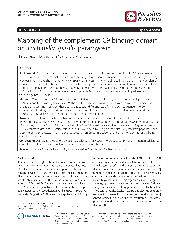摘要
Background: Trichinellosis is an important foodborne zoonosis that is distributed worldwide. Trichinella spiralis may evade host complement-mediated attack by expressing complement inhibitory proteins, such as paramyosin (Pmy). Previous studies have shown that Trichinella spiralis paramyosin (Ts-Pmy) is able to bind to the human complement component C9 to inhibit the complement activation and protect the parasite from complement-mediated attack. Further determination of the complement-binding domain on Ts-pmy will enable us to better understand the Ts-Pmy's biofunction in the immune evasion and provide feasible approach to develop epitope-based subunit vaccine against trichinellosis. @@@ Methods: The complement C9 binding region on Ts-Pmy was determined by expression of overlapped fragments of Ts-Pmy and their binding activities to C9. The exact binding site was further narrowed-down to a 14-amino acid peptide at C-terminus using synthesized peptides with different size of amino acid sequence. The C9 complement-binding of the 14-amino acid peptide and its interference in the C9 polymerization and the complement-mediated lysis of rabbit erythrocytes was investigated. @@@ Results: The protein interaction between human C9 and native Ts-Pmy was further confirmed by immunoprecipitation with T. spiralis lysates. The fragmental expression and C9 binding assays identified that the binding region of Ts-Pmy to C9 is located within 831-885 of Ts-Pmy C-terminus. The exact binding site on Ts-Pmy to C9 was narrowed down to 14 amino acid residues (866Val-879Met) by using different sizes of synthesized peptides. In the presence of the synthesized 14-amino acid peptide, human C9 polymerization and the hemolytic activity of the human complement was inhibited. @@@ Conclusions: Our results revealed the precise molecular basis for T. spiralis to produce Ts-Pmy as an immunomodulator to evade the attack of the host complement system as a survival mechanism.
- 出版日期2014-2-24
- 单位首都医科大学
